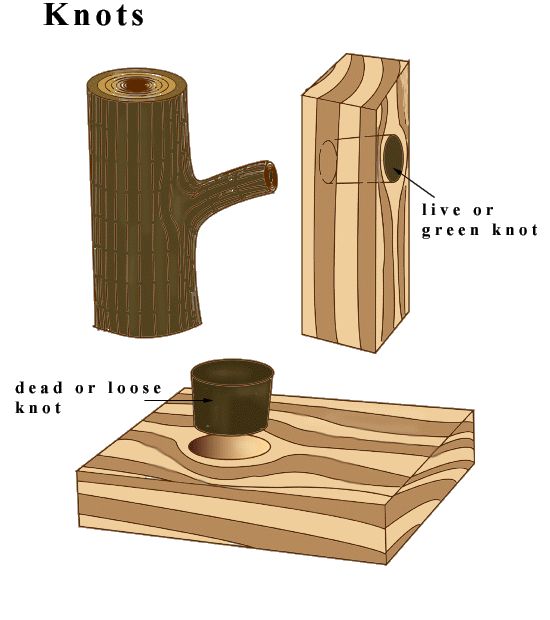Defects in Timber
| Timber is a natural product and is usually not free from imperfections. However what is an imperfection to one person may be a feature or an embellishment to another. For instance, twisted grain is sought after by craftspeople interested in turning bowls or in cutting exotic veneers, whereas for a joiner making a door, twisted grain would be totally unacceptable. A 'defect' is generally an imperfection, which either weakens the wood greatly or makes the wood unsuitable to work with for the purpose it is to be used. There are 2 sources of defects in timber (1) natural defects and; (2) defects which arise once the tree is cut down, either through poor handling or poor seasoning of the tree. |
|
Natural Defects 'Knots' are probably the most common defect in timber. Knots occur where a branch has grown out of the trunk. A lot of knots means the timber is difficult to work and is weakened. Knots are either 'loose' or 'live. Loose knots are no longer connected to the surrounding fibres and very often fall out after the trunk has been converted or the boards have been seasoned. Live knots, on the other hand, remain tightly connected to the surrounding fibres. |

| 'Pitch pockets' occur as a result of injury to the cambium layer(just underneath the bark) while the tree is growing. The bark of a tree can heal small damage to itself with time. However the cambium layer beneath it cannot and the damaged area fills up with resin or sap. A pitch pocket appears as a long narrow slit or opening in the timber board. Pitch pockets are more obvious in softwoods. |
|
A 'compression crease 'is a horizontal
row of kinks in the wood. During storms a tree may be severely
bent by very strong winds. This bending crushes or compresses
cells along a line, which appears as a crease in the timber. 'Spiral grain' is a result of the unusual event of the free twisting as it grows |
|
Other defects:Waney-edge is a conversion defect only. Some of the bark is left on the board which has been taken from the outer part of the tree. |
Materials Wood Rot and Preservation
More Defects